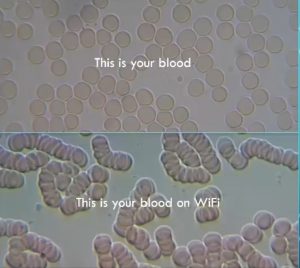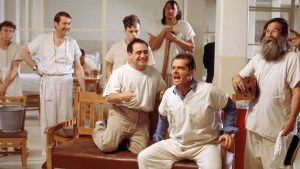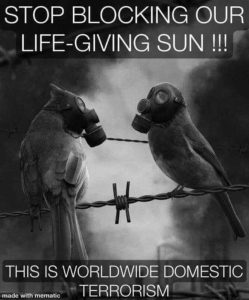
One Flew Over The Cuckoo’s Nest

(Tom: If you have not seen it, you should watch it.)
Actor Kirk Douglas—who had originated the role of McMurphy in the 1963–64 Broadway stage version of the Ken Kesey novel—had purchased the film rights to the story, and tried for a decade to bring it to the big screen, but was unable to find a studio willing to make it with him. Eventually, he sold the rights to his son Michael Douglas, who succeeded in getting the film produced—but the elder Douglas, by then nearly 60, was considered too old for the McMurphy role, which ultimately went to 38-year-old Jack Nicholson. Douglas brought in Saul Zaentz as co-producer.
The film’s first screenwriter, Lawrence Hauben, introduced Douglas to the work of Miloš Forman, whose 1967 Czechoslovak film “The Firemen’s Ball” had certain qualities that mirrored the goals of the present script. Forman flew to California and discussed the script page by page, outlining what he would do, in contrast with other directors who had been approached who were less than forthcoming. Forman wrote in 2012: “To me, [the story] was not just literature, but real life, the life I lived in Czechoslovakia from my birth in 1932 until 1968. The Communist Party was my Nurse Ratched, telling me what I could and could not do; what I was or was not allowed to say; where I was and was not allowed to go; even who I was and was not.”
Zaentz, a voracious reader, felt an affinity with Kesey, and so after Hauben’s first attempt he asked Kesey to write the screenplay, and promised him a piece of the action, but it did not work out and ended in a financial dispute.
Hal Ashby, who had been an early consideration for director, suggested Jack Nicholson for the role of McMurphy. Nicholson had never played this type of role before. Production was delayed for about six months because of Nicholson’s schedule. Douglas later stated in an interview that “that turned out to be a great blessing: it gave us the chance to get the ensemble right.”
Danny DeVito, Douglas’ oldest friend, was the first to be cast, having played one of the patients, Martini, in the 1971 off-Broadway production. Chief Bromden, played by Will Sampson, was found through the referral of a used car dealer Douglas met on an airplane flight when Douglas told him they wanted a “big guy” to play the part. The dealer’s father often sold cars to Native American customers and six months later called Douglas to say: “the biggest sonofab!tch Indian came in the other day!”
Forman had considered Shelley Duvall for the role of Candy; coincidentally, she, Nicholson, and Scatman Crothers (who portrays Turkle) would all later appear as part of the main cast of the 1980 film adaptation of “The Shining”. While screening “Thieves Like Us” (1974) to see if she was right for the role, he became interested in Louise Fletcher, who had a supporting role, for the role of Nurse Ratched. A mutual acquaintance, the casting director Fred Roos, had already mentioned Fletcher’s name as a possibility. Even so, it took four or five meetings, over a year, (during which the role was offered to other actresses such as Angela Lansbury, Anne Bancroft, and Geraldine Page) for Fletcher to secure the role of Nurse Ratched. Her final audition was late in 1974, with Forman, Zaentz, and Douglas. The day after Christmas, her agent called to say she was expected at the Oregon State Hospital in Salem on January 4 to begin rehearsals.
Speaking of the Orgon State Hospital, the producers decided to shoot there, an actual mental hospital, as this was also the setting of the novel. The hospital’s director, Dean Brooks, was supportive of the filming and eventually ended up playing the character of Dr. John Spivey in the film. Brooks identified a patient for each of the actors to shadow, and some of the cast even slept on the wards at night. He also wanted to incorporate his patients into the crew, to which the producers agreed. Douglas recalls that it was not until later that he found out that many of them were criminally insane. (Wikipedia)
Your Being Here Is No Accident

So don’t give up on yourself or your dreams.
Stop Blocking The Sun!

Scammer Trick

Drinking Water
Allegedly from a cardiologist:
When you stand up, gravity holds water in the lower body and swelling of the legs appears.
When you lie down, your lower body is at the kidney level. It is believed by some that it is easier for the kidneys to process fluids when the body is in a horizontal position.
The body needs a certain minimum of water to remove toxins from the body.
Drinking water at a certain point maximally affects the function of the body:
2 cups of water after waking up – helps activate internal organs
1 glass of water 30 minutes before eating – helps digestion
1 glass of water before bath – helps lower blood pressure
1 glass of water before bed – reduces risk of stroke or heart attack
In addition, water before bedtime also helps prevent leg cramps at night.
The leg muscles need fluid because they contract, and due to lack of fluid, you can wake up with a muscle spasm.
(Tom: How many people do you know that say they don’t want to drink water before bed because they have to get up at night because of it?
The solution to needing to get up at night is simple. Just don’t drink between 5 o’clock and your glass of water at bedtime.
It’s not the bedtime drink of water that is the problem. It is that bedtime drink of water added to what you drank during the preceding 5 hours that causes the need to go to the bathroom in the middle of the night.)
Allicin In Garlic

Coming Up To Election Time In The USA, Are you Prepared For The Next One?

The Best Revenge

Covid Inquiry 2.0

Peter Fam speaks on the International Covenant on Civil and Political Rights (https://www.ohchr.org/en/instruments-mechanisms/instruments/international-covenant-civil-and-political-rights). Vital to know and share so we can restore our rights. (The eighteenth video down the page.)
